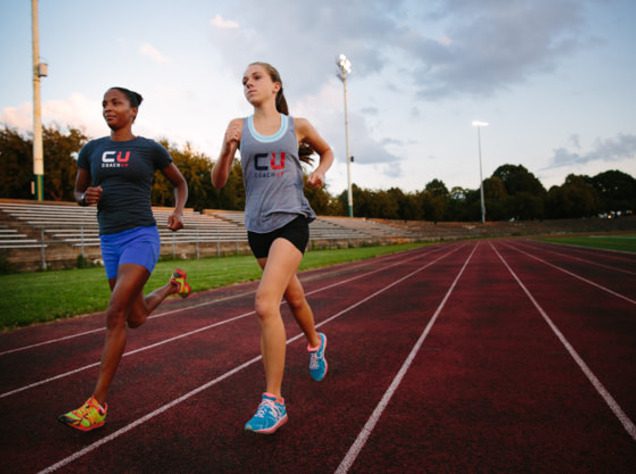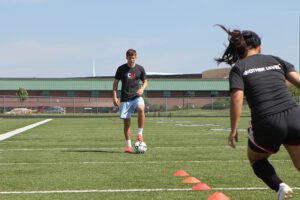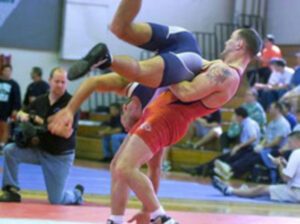Simply put, speed is critical for any sprinter, duh, right? However, what people don’t often understand are the immense benefits of training for speed improvement. Initially, many people may perceive speed as a natural-born skill, as an ability that you either have or don’t. But, that couldn’t be further from the truth as it can be a fined-tuned skill as well. Like reading or any other skill, speed is something that can be taught and improved drastically.
The simplest, most immediate way to gain speed is to master proper sprinting mechanics and technique, even at the expense of actual speed training. You can’t run fast without knowing how to efficiently do it! Then, you’ll piece together those skills, adding speed as you go, and ta-da! You’ll have improved your sprint speed, but before we get ahead of ourselves, we hop back to beginning and build from square one.

Factor in Form
The two factors that contribute to speed are stride length and frequency. Thus, proper sprinting form and mechanics maximize these two variables. The two main phases of speed and acceleration greatly differ in body positions and function, so learning them both is crucial. As an athlete accelerates, there is a transitional phase to maximum speed. After which, maximum speed or velocity is maintained for as long as possible before muscle fatigue sets in and the athlete is inevitably forced to slow down.
The acceleration position involves driving out at a 45° angle from the ground, pushing into the track with each step. This angle serves to generate force so that the foot hits the ground while also simultaneously exploding off of it, increasing stride length and force output. Pure acceleration lasts for a distance of about ten yards and this technique allows the athlete to cover large distances in the least amount of steps possible.
On the other hand, maximal velocity position is a little more difficult. After an athlete transitions to the maximal velocity position, they should shift vertically between 80° and 85° from the ground. In this position, the athlete is pulling the leg back as the foot strikes the ground which will, in turn, optimize stride length. This technique requires strong glutes and hamstrings as well as good hip flexion. Although there are different stages within a sprint, these key technical factors should generally be maintained throughout in order to maximize speed.
Arms
- Keep your arms moving front to back in a smooth motion, not letting them cross your body.
- Your arms work as a lever, so extend your fingers out. Clenching your hands into fists will produce less force, tense up your arm, and waste energy.
- Your arm movements should balance your leg motions. As your left leg drives forward, your left arm should, too.
- Your hand should be level with your chin with a closed angle between your forearm and biceps.
- From here, throw your hand down with as much force as possible. Then, your elbow should drive back as far as possible, so that there’s a 90° angle between your triceps and your back.
Shoulders
- When using your upper-body to propel you forward, try engaging your shoulders instead of arms.
- Make sure to keep the shoulders relaxed and low, not clenched or shrugged.
Posture
- Keep the trunk at a neutral angle without tilting the pelvis, while additionally not leaning forwards or backwards.
- Think of your posture as a straight line from head down through the hips and the balls of your feet.
- Align the hips so that they are facing straight down the track.
- Finally, your core should be locked and strong, engaging these muscles will not only increase your top speed in an actual race, but will also strengthen and test your muscles for next time.
Head
- Relax your facial muscles and neck, straining unnecessary parts of your body will only take away from your overall effort and ability elsewhere.
- Keep your head straight and still, looking forward and slightly down at the track *
(Related: Read about executing the handoff in relay races here.)
Huddle Up
The overall objective of sprinting is to run as fast as possible, that should go without saying. However, unless proper mechanics and technique are utilized, you’ll honestly never reach your full potential. Speed only improves when stride length and stride frequency are increased in an efficient fashion. To improve one or both of these variables, focus on executing good form over any training exercise. Remember, when you’re training for form, don’t sacrifice it for speed. Start slowly with your form and then build from there. Only once these different elements are mastered will sprinting with speed and efficiency come easier.
However, if you’re working towards putting it together and having trouble with a few of these aspects, don’t hesitate to book one of CoachUp’s private trainers to speed the process along. Our skilled team will notice small flaws and easy fixes in your form that will help take your game to another level. What are you waiting for?
Be prepared for the biggest moments by mastering the small ones off the track.
How useful was this post?
Click on a star to rate it!
Average rating 4.6 / 5. Vote count: 9
No votes so far! Be the first to rate this post.



